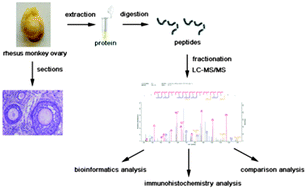Unravelling the proteome of adult rhesus monkey ovaries†
Abstract
Ovarian physiology and pathology are important areas of scientific research. Efforts have been made to identify the ovary-related transcriptomes in different species. However, the proteomic studies are limited. The rhesus monkey is very similar to humans, and it is widely used in the study of reproductive biology and medicine. In this study, using an optimized proteomics platform, we successfully identified 5723 rhesus ovarian proteins, of which 4325 proteins were consistently identified in all three replicates and with at least 2 unique peptides. The 4325 proteins were chosen for further analysis. Through gene ontology and pathway analyses, we obtained a preliminary understanding of the function of these proteins. A random immunohistochemistry analysis was used to determine the expression of proteins in various cell types. By comparing the genes identified in this study with genes that were reported to have relatively high levels of expression in human oocytes, we obtained genes that were predicted to play roles in maintenance of normal ovarian physiology. Searching the identified genes from this study against the MGI database gave us a list of proteins those exist in the rhesus monkey ovary and are important for female mouse reproduction as well. The overlap of genes in this study and the genes whose abnormal expression or dysfunction were reported to be associated with human polycystic ovary syndrome (PCOS) and premature ovarian failure (POF) prompted us to use the rhesus monkey to study these two common causes of female infertility. This study may provide a basis for future studies of human reproductive disorders using the rhesus monkey as a model.


 Please wait while we load your content...
Please wait while we load your content...